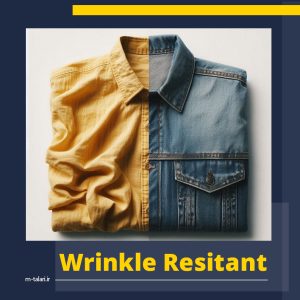Fiber content, weave type, and finishing treatments are the most important parameters for fabric wrinkle resistance. Here you can find some more information about these parameters in detail:
Fiber Content:
Natural Fibers:
Cotton: Prone to wrinkles due to its cellulose structure. Wrinkle-resistant cotton exists but usually involves chemical treatments.
Wool: Naturally wrinkle-resistant due to its keratin fibers and crimp.
Linen: Wrinkles easily due to its stiff cellulose fibers but often valued for its rumpled aesthetic.
Silk: Highly wrinkle-resistant due to its smooth protein fibers.
Synthetic Fibers:
Polyester: Generally wrinkle-resistant due to its hydrophobic nature.
Nylon: Moderately wrinkle-resistant, can wrinkle more than polyester.
Acrylic: Highly wrinkle-resistant, but can feel less comfortable due to lower breathability.
Weave Type:
Tighter weaves: Generally more wrinkle-resistant than looser weaves as threads lie closer together for example twill weave.
Looser weaves: Prone to wrinkling as threads have more space to move and crease for example open Plain weave.
Textured weaves: May hide wrinkles better than smooth weaves due to their uneven surface for example waffle weave.
Finishing Treatments:
Chemical finishes: Formaldehyde-based resins, silicones, etc. can stiffen fibers and reduce wrinkling, but can impact breathability and comfort.
Mechanical finishes: Calendaring, brushing, etc. can smooth fibers and reduce wrinkling, but the effects may be temporary.
Natural finishes: Starch, beeswax, etc. can offer some wrinkle resistance with less impact on breathability.
Additional Factors:
Fabric weight: Heavier fabrics tend to drape better and wrinkle less than lightweight ones.
Moisture content: Damp fabrics wrinkle more easily than dry ones.
Storage and care: Proper storage and care can minimize wrinkles.

 فارسی
فارسی
